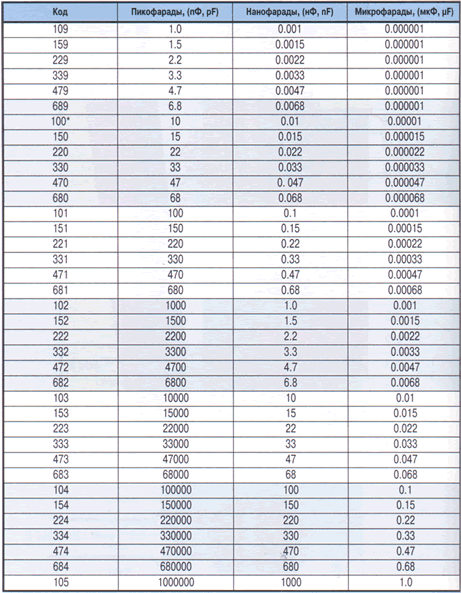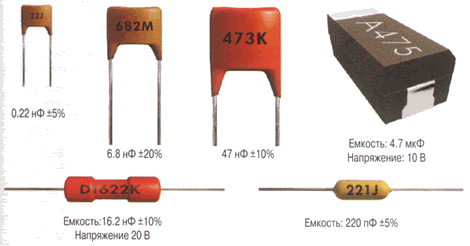Capacitors. Character encoding. Reference data

Encyclopedia of radio electronics and electrical engineering / Reference materials
 Comments on the article
Comments on the article
In accordance with IEC standards, four ways of coding the nominal capacitance are used in practice.
1. Encoding with 3 digits
The first two digits indicate the value of the capacitance in picofarads (pf), the last - the number of zeros. When the capacitor has a capacitance of less than 10 pF, then the last digit can be "9". For capacitances less than 1.0 pF, the first digit is "0". The letter R is used as the decimal point. For example, code 010 is 1.0 pF, code 0R5 is 0.5 pF.

* Sometimes the last zero is not indicated.
2. Encoding with 4 digits
4-digit coding options are possible. But in this case, the last digit indicates the number of zeros, and the first three indicate the capacity in picofarads (pF).

examples:





3. Capacitance marking in microfarads
The decimal point can be replaced by the letter R.
4. Mixed alphanumeric marking of capacity, tolerance, TKE, operating voltage
Unlike the first three parameters, which are marked in accordance with the standards, the operating voltage of different companies has different alphanumeric markings.
Publication: cxem.net
 See other articles Section Reference materials.
See other articles Section Reference materials.
 Read and write useful comments on this article.
Read and write useful comments on this article.
<< Back
 Latest news of science and technology, new electronics:
Latest news of science and technology, new electronics:
A New Way to Control and Manipulate Optical Signals
05.05.2024
The modern world of science and technology is developing rapidly, and every day new methods and technologies appear that open up new prospects for us in various fields. One such innovation is the development by German scientists of a new way to control optical signals, which could lead to significant progress in the field of photonics. Recent research has allowed German scientists to create a tunable waveplate inside a fused silica waveguide. This method, based on the use of a liquid crystal layer, allows one to effectively change the polarization of light passing through a waveguide. This technological breakthrough opens up new prospects for the development of compact and efficient photonic devices capable of processing large volumes of data. The electro-optical control of polarization provided by the new method could provide the basis for a new class of integrated photonic devices. This opens up great opportunities for ... >>
Primium Seneca keyboard
05.05.2024
Keyboards are an integral part of our daily computer work. However, one of the main problems that users face is noise, especially in the case of premium models. But with the new Seneca keyboard from Norbauer & Co, that may change. Seneca is not just a keyboard, it is the result of five years of development work to create the ideal device. Every aspect of this keyboard, from acoustic properties to mechanical characteristics, has been carefully considered and balanced. One of the key features of Seneca is its silent stabilizers, which solve the noise problem common to many keyboards. In addition, the keyboard supports various key widths, making it convenient for any user. Although Seneca is not yet available for purchase, it is scheduled for release in late summer. Norbauer & Co's Seneca represents new standards in keyboard design. Her ... >>
The world's tallest astronomical observatory opened
04.05.2024
Exploring space and its mysteries is a task that attracts the attention of astronomers from all over the world. In the fresh air of the high mountains, far from city light pollution, the stars and planets reveal their secrets with greater clarity. A new page is opening in the history of astronomy with the opening of the world's highest astronomical observatory - the Atacama Observatory of the University of Tokyo. The Atacama Observatory, located at an altitude of 5640 meters above sea level, opens up new opportunities for astronomers in the study of space. This site has become the highest location for a ground-based telescope, providing researchers with a unique tool for studying infrared waves in the Universe. Although the high altitude location provides clearer skies and less interference from the atmosphere, building an observatory on a high mountain poses enormous difficulties and challenges. However, despite the difficulties, the new observatory opens up broad research prospects for astronomers. ... >>
 Random news from the Archive Random news from the Archive The brain turns words into pictures
04.04.2015
When learning new words, our brain shifts from reading letters to perceiving the word as a single visual image, researchers from Georgetown University came to such conclusions. Their experiment involved 25 people who were asked to learn a set of specially made up nonsense words. In parallel, with the help of functional magnetic resonance imaging, the work of the brain was monitored. It turned out that as the proposed verbal nonsense was learned, the activity of neurons changed. That is, at first they perceived the new word as something incomprehensible, consisting of separate characters, but then it became familiar, and was included in the dictionary as a single "picture".
For a long time it was believed that text recognition in the neural apparatus occurs by letter. At first glance, this is how it should be, because words consist of letters, and we ourselves learn to read, analyzing what is written letter by letter. However, in 2009, in the journal Neuron, Maximilian Riesenhuber and his colleagues published an article describing the activity of the region of the left visual cortex, which recognizes words immediately and completely. (By the way, the symmetrical area in the visual cortex on the right is responsible for face recognition.) Of course, the question immediately arose of how the "visual dictionary" is formed. This is where the invented words were needed, which the participants in the new experiment had to learn.
As a result, neuroscientists were able to see how visual neurons gradually tune in to a new vision of the text, how the transition from reading by letter to recognizing the word as a whole takes place. Obviously, this speeds up and facilitates reading - as well as recognizing faces as a whole, and not by individual features, helps to quickly recognize another person and facilitates communication.
New data may help those people who have neurological problems with reading. It happens that the brain is simply not able to learn words by the usual spelling method, like a sequence of letters. And then, perhaps, a method in which the emphasis would not be on letters, but on the word as a single visual image, would come in very handy. Perhaps, by stimulating the corresponding zone of the visual cortex, we can achieve great success in learning foreign languages. True, in addition to writing, you also need to know the pronunciation of words, but for this you already need to turn to other parts of the brain - those that are responsible for the perception and analysis of speech sounds.
|
 Other interesting news:
Other interesting news:
▪ Nanowires on graphene grow by themselves
▪ Electric vehicles as part of a common electrical grid
▪ Fear of pain and brain activity
▪ New unit of measure - kettabyte
▪ Anti-sleep device from Ford
 News feed of science and technology, new electronics
News feed of science and technology, new electronics
 Interesting materials of the Free Technical Library:
Interesting materials of the Free Technical Library:
▪ section of the Electrician website. Article selection
▪ article Medical physics. Crib
▪ article How did cutlery come about? Detailed answer
▪ article Kuril Islands. Nature miracle
▪ article Remote stop and reverse start of the counter. Encyclopedia of radio electronics and electrical engineering
▪ article Block of protection of the equipment. Encyclopedia of radio electronics and electrical engineering
 Leave your comment on this article:
Leave your comment on this article:
Comments on the article:
Nicholas
Thank you for your help.
 All languages of this page
All languages of this page
Home page | Library | Articles | Website map | Site Reviews

www.diagram.com.ua
2000-2024







 Arabic
Arabic Bengali
Bengali Chinese
Chinese English
English French
French German
German Hebrew
Hebrew Hindi
Hindi Italian
Italian Japanese
Japanese Korean
Korean Malay
Malay Polish
Polish Portuguese
Portuguese Spanish
Spanish Turkish
Turkish Ukrainian
Ukrainian Vietnamese
Vietnamese







 Leave your comment on this article:
Leave your comment on this article: